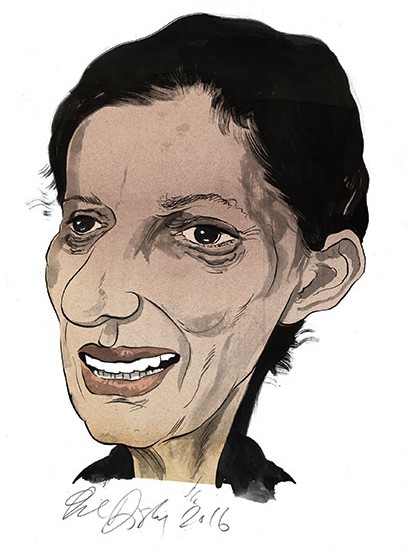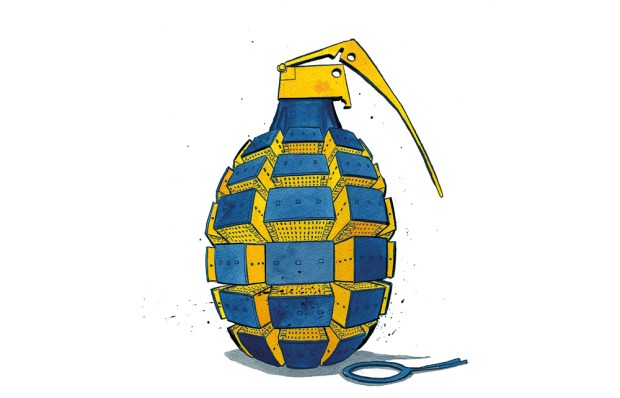Pakistan society intended Seema Aziz to be a wife and mother. Her father arranged for her to get married at a young age, and by her early thirties she had a comfortable life as a Lahore housewife, married to a chemical engineer.
Then she took charge of her own fate. In the late 1970s, well before the era of jihad, Pakistan was flooded with western products. People began wearing jeans and T-shirts, leading Seema to conclude that there was a market for high-quality Pakistani clothes produced locally. She opened her first shop in 1985, when she was 34, in Lahore’s ancient cloth market. Her family told her they were ashamed because she had gone into business, but her instincts were vindicated: the clothes flew off the shelves. ‘Later I came to understand what entrepreneur means: you create a product that people don’t know they need with money that does not exist.’ Today she controls an empire of 450 Bareeze stores (translated as Blessing of God) across Pakistan and the Middle East. Seema is the country’s most successful businesswoman, which in itself makes her amazing. What makes her extraordinary, however — and a figure who should be celebrated internationally — is something else.
Seema Aziz’s schools have rarely been written about in the West. This is probably because they disprove every western prejudice about Pakistan. They are a story of success and not disaster; about hope rather than despair. They do not boost the profile of western politicians coming to the rescue of a failed state. No western aid agency helped to get them established.
Today Seema operates 256 schools, many in rural areas. They give a sound education to boys and girls who would otherwise be illiterate, and many of her alumni have gone on to become teachers themselves. Others have trained as engineers, businessmen and women, doctors, surgeons, soldiers — their lives utterly transformed by Seema Aziz and her CARE schools. Indeed, they are now starting to change Pakistan itself, helping this beautiful but damaged country make use of the abundant talents of its population.
The story begins in 1988, when the Ravi river, which flows through Lahore, was about to overflow after heavy rains. Engineers saved the city by bursting the banks so that water escaped into the surrounding country. But countless homes and villages were washed away as the water rose.
Seema had set up a factory in one of these villages, so she travelled to the stricken area. At first she concentrated on building new homes and delivering food and clean water. ‘There was no sewerage, no drinking water, no electricity, no roads,’ she recalls. ‘It was absolutely heartbreaking, only 15 miles outside Lahore, the cultural centre of Pakistan. I became like the pied piper, with hundreds of children following me around, all barefoot, matted hair, runny noses.’
Seema asked why the children were following her. She was told that there were no schools and they had nowhere to go. That was the lightbulb moment when she made the decision that would go on to transform the lives of so many of her fellow citizens.
Her decision to set up a school and provide those children with an education did not meet with universal support, however. Many ridiculed her when some of the children who would attend her school didn’t even have a home or a roof over their heads. Others told her that ‘The poor don’t want to study.’ Her response: ‘Everyone wants a better life for their children.’
‘I put the money together, begging it from friends and family,’ she remembers today. ‘I counted the bricks. I signed every bag of cement so it wouldn’t be stolen. The day we opened the doors — 17th January, 1991 — there were 250 children standing outside, all barefoot and with the same matted hair. Little children with a shawl and no trousers. Or trousers but no shawl. The first week we gave everyone a towel and soap and a comb.’ By the start of the second year there were 450 pupils, and a year later the number had doubled again to 850. For the first four years Seema drove herself out of Lahore to the school every day. During that time she painstakingly established the principles and systems that today guide all CARE schools across Pakistan.
‘I wanted to give boys and girls an equal chance,’ she says. ‘There was no way I could segregate them.’ This challenged the rule that all schools should be single-sex. ‘For many years I was terrified,’ remembers Seema, ‘because I feared that if we failed we would take back the cause of education and freedom and equality.’
A setback came when her policy was attacked by a politician on religious grounds, forcing Seema to announce that the school would close its doors. The following morning 500 parents had gathered outside the school gates demanding that it should be kept open. The politician retreated.
The second principle guiding Seema’s schools is the teaching of English. This, too, was regarded by some as heretical: many leading Pakistani politicians, Imran Khan included, have insisted on the use of local languages. But Seema maintains that refusal to teach English amounts to apartheid, because it cuts pupils off from Pakistan’s cultural, business and political elite. ‘How can I say that my children will go to English schools, but I will open schools where children only study in Urdu?’ asks Seema. ‘We are educating the children of our nation, the future of our country. We must give them a fair chance.’ Equally controversial has been her third guiding principle: that her schools should charge a fee. ‘There are two things wrong with the idea of free education,’ says Seema. ‘People don’t have a stake in it, so they don’t take ownership. I don’t want any child growing up believing they are being educated on charity.’
After four years, Seema was ready to open a second school, and soon afterwards a third. In 1998, the Punjab government, impressed by her success, asked her to take over a group of 10 failing government schools in the suburbs of Lahore. But, says Seema, ‘they had no toilets, no drinking water, no library. In some schools I found children doing guard duty, or massaging teachers’ legs, making tea, looking after teachers’ children. This was not education.’
For two years teaching unions blocked her reforms, but in the end she was successful. Today CARE educates approximately 175,000 children. Huge though the number sounds, however, it is still a drop in the ocean: there are estimated to be 52 million children in Pakistan, of whom barely half attend a school of any kind.
Many of those who do are pupils at one of the country’s notorious government schools. We visited one in Mal, just a few miles away from the country estate of the Punjab chief minister, Shabaz Sharif. The children were dirty and the classrooms squalid. There were supposed to be five teachers at the school, but only three were present. One of them was on the phone while simultaneously teaching several different age groups.
In one primary school we found two teachers in charge of 101 children. At another, the classrooms were empty, while three teachers sat in the courtyard in front of a blank whiteboard. When we arrived, they stood up and apologetically started to teach. Many government teachers don’t believe the poor are worth the attention. Others have multiple jobs.
The record of these government schools is dreadful. In rural areas, 43 per cent of ten- year-olds can’t read a sentence in English, and 37 per cent can’t read elementary Urdu.
By contrast, when we visited Seema’s schools (all funded by private Pakistani donors) the classes were full. There was a sense of purpose. Children stood up when we entered the room. We detected a palpable sense that education is precious.
As our time in Lahore came to an end, we asked Seema to take us back to Sheikhupara, where she launched CARE schools 25 years ago. As we drove across the Ravi river she told us that she herself had only been allowed to study home economics at school. ‘I can never forget that when I wanted to apply for a master’s, my father said, “You’re crazy. You’ve studied enough already. Now get married!” ’ When she did eventually take her bar exams in her mid-thirties, she came top in the national exams.
Graduates from Seema’s schools are an inspiring bunch. We met 22-year-old Muhammad, who owns a call-centre business employing 30 people. Fatima, a confident young woman, also aged 22, won a scholarship to Lahore’s University of Technology and Engineering to read civil engineering. She now works as a consultant to a big firm and plans to do a PhD. We asked whether she was bothered that she was not married. ‘I have not thought of it yet,’ she told us.
Muhammad Azam, the son of a casual labourer, told us how he is now in the final year of a cardiology degree. There is no other graduate in his entire extended family. We also met Umair Ali Akmar, a musical prodigy who regularly performs in front of the prime minister. She told us that but for CARE she would never have learnt that she had any talent, let alone pursued a musical career.
As we prepared to leave Lahore, we asked Seema Aziz what she planned to do next. She said she’d like to expand CARE schools to teach one million children. ‘Because I believe education is the right of every child. We must reach every child. We want to change the destiny of this country. Because the thing about education is that it’s not one person that you are educating — it’s for ever. An educated person will never allow their child to be illiterate.’
Got something to add? Join the discussion and comment below.
Get 10 issues for just $10
Subscribe to The Spectator Australia today for the next 10 magazine issues, plus full online access, for just $10.
You might disagree with half of it, but you’ll enjoy reading all of it. Try your first month for free, then just $2 a week for the remainder of your first year.














Comments
Don't miss out
Join the conversation with other Spectator Australia readers. Subscribe to leave a comment.
SUBSCRIBEAlready a subscriber? Log in